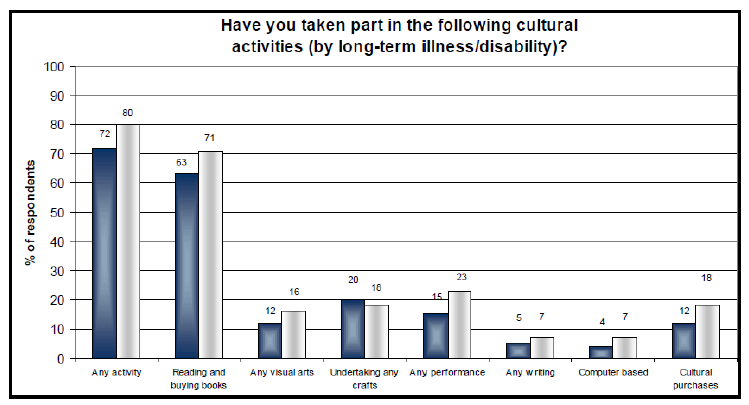Scottish Government Equality Outcomes: Disability Evidence Review
This evidence review was prepared to support the production of the Scottish Government's Equality Outcomes, with regard to disability.
15 Culture
15.1 This section explores disabled people's engagement with culture, and then looks at barriers to further engagement.
Degree of engagement
15.2 In 2011, the Scottish Household Survey[104] reported that the percentage of adults who engaged in culture in the previous 12 months (i.e. those who attended a cultural event or place or participated in a cultural activity) was 78% for those with a disability, 80% for those with an illness or health problem, 73% for those with both and 91% for those without.
15.3 Adults with either a disability (53%), illness or health problem (63%) or both (53%), were much less likely to attend a cultural event than those without (82%). This is particularly notable for cinema attendance, which was 26% for adults with a disability, 35% for those with an illness or health problem, and 24% for those with both, compared with 62% for those without.
15.4 The differences are considerable for attendance at a number of other types of cultural event or place. For instance, the percentage of adults who attended a live music event was 16% for those with a disability, 19% for those with an illness or health problem, 13% for those with both and 35% for those without.
15.5 Adults with a disability (67%), or illness or health problem (69%) or both (63%) are less likely to participate in cultural activities than those without (76%). This is most notable for dance participation, which was 10% for adults with a disability, 13% for those with an illness or health problem, 6% with both those two categories and 20% for those without.
15.6 The 2007/8 Scottish Household Survey offers finer-grained detail[105]. Figure 10 shows participation in different cultural activities, where the dark bars show the percentage of disabled respondents, and the pale bars show non-disabled respondents. Respondents with long-term illnesses or disabilities were less likely to participate in cultural activities overall (72% v 80%), but the differences are not large. The biggest gap is in the performance category (15% for disabled people v 23% for non-disabled people), which is unsurprising since some activities within this category require mobility in order to participate. Visual impairment and reading difficulties are likely to be contributing factors to the relatively large gap in reading and purchasing books (63% v 71%). It is noticeable that those with a long-term illness or disability were more likely to participate in craft based activities than those with no long-term illness or disability (20% v 18%).

Figure 10: Cultural participation of respondents with and without LLTI (Source: Scottish Household Survey, 2007/08)
15.7 National Indicator data from Scotland Performs[106] (2012) show that fewer adults with a disability, illness or health problem use the internet for personal use than non-disabled adults. Around half of those with a disability, illness or health problem use the internet for personal use, compared to over eight out of ten for the rest of the population. The increases seen in internet usage over the four years 2008-12 are comparable across those with and without a disability, illness or health problem.
Barriers
15.8 A qualitative study from 2002[107] on increasing access to the performing arts for visually impaired performers and audiences, although based on London, explored the barriers that prevent or inhibit visually impaired people from attending performance arts events. Cultural barriers found included:
- visually impaired people have low expectations about how they will be welcomed and treated at performing arts venues;
- as a result, many believe that theatre, opera and dance are 'not for them';
- sighted people make incorrect assumptions about the abilities, needs and interests of visually impaired people; and
- visually impaired people sometimes encounter fear and hostility if frontline staff have not been properly trained.
15.9 Other barriers included: cost, since more visually impaired people are unemployed and on lower incomes than sighted people (concessionary tickets are not always accessible to visually impaired customers); transport to and from the venue is an issue; communication and awareness (e.g. there is a lack of non-visual information at venues); and the number of audio-described performances is still low.
15.10 The Museums, Libraries and Archives Council in England [108]reports that its first national survey (in 2001) of provision for disabled users of museums, libraries and archives highlighted a growing body of good practice, as well as significant barriers in most areas affecting access and equality for disabled people. Access for disabled people was widely understood to mean wheelchair access, and commitment to disability access was lacking at senior and board level in museum, library and archive services. The main aims of its second national survey (in 2005) were to determine the extent to which :
- disability access had become integral to the workings of museums, libraries and archives, and
- measures had been taken to remove common access barriers and provide accessible services.
15.11 It found that real improvements in access for disabled people had taken place over the previous five years. However, it also observed that (at the time of writing) access and equality for disabled people in the cultural sector remained 'unfinished business'. It concluded that the long term removal of remaining and emerging access barriers would require ongoing and systematic commitment.
Contact
Email: Social Research
There is a problem
Thanks for your feedback